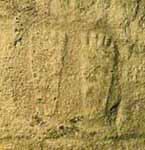- Home
- Megalithism in Morbihan
- Le Petit-Mont
- Petit-Mont Art
- Grave IIIa
The entire decoration is so elaborate, varied and original that some elements pose a problem. Taking into account the panels that were destroyed during the war (now known through the drawings, photos and mouldings that made partial restitution possible), there are no less than twelve decorated slabs in this crypt (nine in the chamber and three in the passage).
The most common decoration is the zigzag line, found on seven stones, whereas the "classic" signs of Armorican megalithic art, i.e: two horn-shaped elements, no obvious axe or shield, are rarely found.
In the passage, two slabs display a "draped" motif with boxed chevrons reminiscent of the "Gavrinis style", even more clearly than those found in cairn II nearby.
On the other hand, there are two unusual patterns in the chamber walls: a "wire wheel" and two human feet in a rectangular cartouche (however in this case the different technique and the lack of coherence with the surrounding decoration points to a later addition).
A part of the "draped" motifs made from interconnecting broken lines.
A part of the "draped" motifs made from interconnecting broken lines.
The "wire wheel", which was probably a solar symbol, exceptional in Armorican megalithic art, sits imposingly in the centre of a slab in chamber IIIa.
The "two feet" picked out in low-relief in the centre of another panel (from a molding, because the original motif was destroyed during World War 2).



